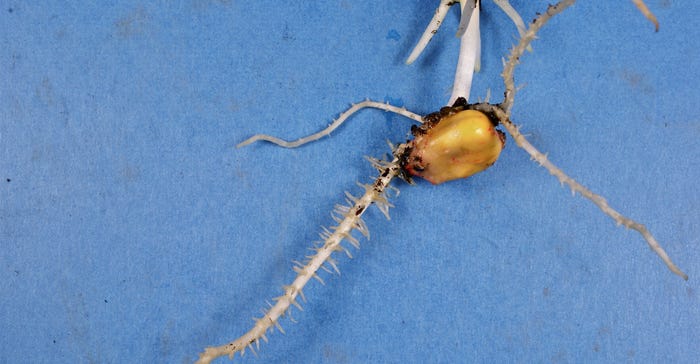June 8, 2020

Although there is no evidence of widescale problems with herbicide carryover injury to corn or soybeans this spring, Iowa State University Extension field agronomists have received a few reports. ISU Extension weed management specialist Bob Hartzler says the potential for carryover injury is determined by several factors. They include:
persistence of the herbicide
soil characteristics
amount of rainfall following the application
interval between herbicide application and planting the rotational crop
sensitivity of the crop and early-season crop vigor
The majority of active ingredients used in Iowa are not persistent enough to pose a carryover risk, Hartzler says. Herbicide products that have half-lives sufficient to result in occasional carryover include atrazine, chlorimuron, clopryalid, cloransulam, fomesafen, imazethapyr, isoxaflutole and mesotrione. Atrazine and chlorimuron probably pose the greatest risk, particularly on soils with high pH, but most farmers have learned where and at what rates these products can be used safely.
Less time for herbicides to degrade
A high percentage of herbicide applications were made later than normal in 2019. “Combine delayed applications in 2019 with 2020’s record planting pace, and we have a reduced time frame for herbicides to degrade in the soil,” he says. “In addition, certain areas of the state experienced dry weather last summer. These factors could result in crops being suppressed by sublethal herbicide residues in some fields. With the products used today, the loss of corn or soybean stand is rare — and crops usually grow through the carryover damage relatively quickly.”
The areas of Iowa that had dry weather last summer and thus have an increased chance of herbicide carrying over to this year can be found at the Drought Monitor.
When diagnosing early-season problems in crop fields, a basic understanding of herbicide mode of action is essential to determine whether herbicides are contributing to the problem. Photos provided by Hartzler in the accompanying slideshow with this article illustrate symptoms associated with herbicide injury. He offers the following explanation of which herbicide groups to keep an eye on:
Herbicide group HG 2. These are imazethapyr, cloransulam, chlorimuron. ALS inhibitors are systemic and affect areas of rapid growth by inhibiting synthesis of amino acids. The distinct symptom of Group 2 herbicides is bottle brush roots on corn, but crop stunting and chlorosis are also associated with carryover. Symptoms can be subtle and difficult to identify.
Herbicide Group HG 4. Growth regulators such as clopyralid are systemic and mimic the activity of auxin, a plant hormone. Typical symptoms are epinasty and distorted leaf veins. Soil residues of clopyralid typically do not cause the uniform distortion of leaves associated with drift of 2,4-D or dicamba.
Herbicide Group HG 14. Fomesafen is the one PPO inhibitor herbicide that occasionally injures corn following use in soybean field the year before. While there is little movement in plants with postemergence applications of Group 14 herbicides, residues in the soil move via the xylem to photosynthetically active leaves. Symptoms are very distinctive, producing chlorosis of leaf veins and necrosis. The mid-vein may break midway in the leaf. Most users have learned to switch to other products after mid-June to reduce risks of fomesafen carryover.
Herbicide Group HG 27. Isoxaflutole and mesotrione are HPPD inhibitor herbicides that can cause chlorosis and bleaching of foliage via their activity on pigment synthesis.
About the Author(s)
You May Also Like






